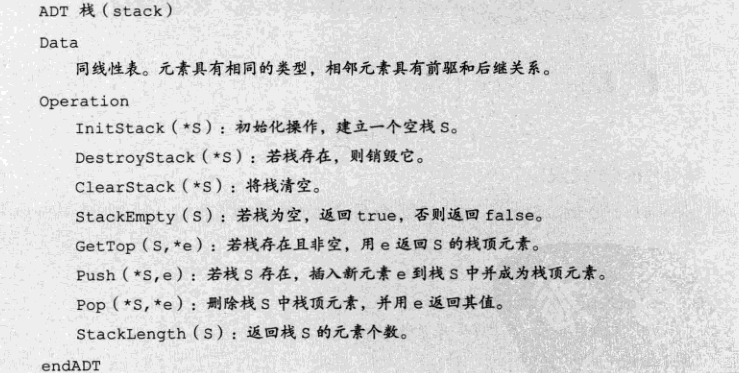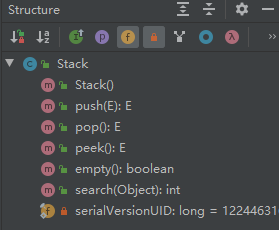数据结构-栈
# 栈与队列

栈
概念
栈:是限定仅在表尾进行插入和删除操作的线性表。
栈顶(top):允许插入和删除的一端,即表尾称为栈顶
栈底(bottom):表头称为栈底
栈是LIFO结构,后进先出。
与线性表相比,特殊之处在于
限制了线性表的插入和删除位置,始终在栈顶进行。
所以栈底是固定的,最先进栈的只能在栈底
相关操作
栈的插入操作 —> 进栈(圧栈、入栈)
栈的删除操作 —> 出栈(弹栈)
假设入栈元素从小到大,出栈的每个元素后面比该元素小的元素,应该按从大到小的相对顺序排列
比如数字元素1、2、3依次进栈,
出栈顺序可能是 1、2、3 / 1、3、2 / 2、1、3 / 2、3、1 / 3、2、1
不可能是 3、1、2 的出栈顺序。
抽象数据类型

栈的顺序存储结构
用数组实现
ArrayStack.java
package com.stack;
/**
* 用数组实现的顺序表
* 限制操作端,使其成为栈
*/
public class ArrayStack {
private int maxSize;
private int[] stack;
private int top = -1;
public ArrayStackDemo(int maxSize) {
this.maxSize = maxSize;
stack = new int[maxSize];
}
public boolean isFull() {
return top == maxSize - 1;
}
public boolean isEmpty() {
return top == -1;
}
public void push(int value) {
// 入栈
if (isFull()) {
System.out.println("栈满了");
return;
}
stack[++top] = value;
}
public int pop() {
// 出栈
if (isEmpty()) {
throw new RuntimeException("栈空");
}
return stack[top--];
}
public void list() {
if (isEmpty()) {
System.out.println("没有数据");
return;
}
for (int i = top; i >= 0; i--) {
System.out.printf("stack[%d]=%d\n",i,stack[i]);
}
}
}
栈的链式存储结构
简称链栈
LinkStack.java
package com.stack;
/**
* 因为头结点是必须的,栈顶指针也是必须的。
* 所以合二为一!即初始化的时候不需要头结点
*/
public class LinkStack {
private Node top;
public boolean isFull() {
return false;
}
public boolean isEmpty() {
return top == null;
}
public void push(int num) {
// 很少满栈,直接创建结点头插
Node node = new Node(num);
node.next = top;
top = node;
}
public int pop() {
// 出栈
if (isEmpty()) {
throw new RuntimeException("栈空");
}
int value = top.data;
top = top.next;
return value;
}
public void list() {
if (isEmpty()) {
System.out.println("没有数据");
return;
}
Node temp = top;
while (temp != null) {
System.out.print(temp.data+"\t");
temp = temp.next;
}
}
}
class Node{
public int data;
public Node next;
public Node() {
}
Node(int data) {
this.data = data;
}
}
Java中自带封装好的Stack类,可以直接使用。

底层继承关系 class Stack<E> extends Vector<E>
用数组存储,如果栈满会自动扩容。
对比
顺序栈与链栈,它们在时间复杂度上是一样的,均为0(1)。
对于空间性能,顺序栈需要事先确定一个固定的长度,可能会存在内存空间浪费的问题,
但它的优势是存取时定位很方便,
而链栈则要求每个元素都有指针域,这同时也增加了一些内存开销,但对于栈的长度无限制。
所以它们的区别和线性表中讨论的一样,如果栈的使用过程中元素变化不可预料,有时很小,
有时非常大,那么最好是用链栈,反之,如果它的变化在可控范围内,建议使用顺序栈会更好一些。
栈的作用
- 递归
- 逆波兰式
- 中缀转后缀

